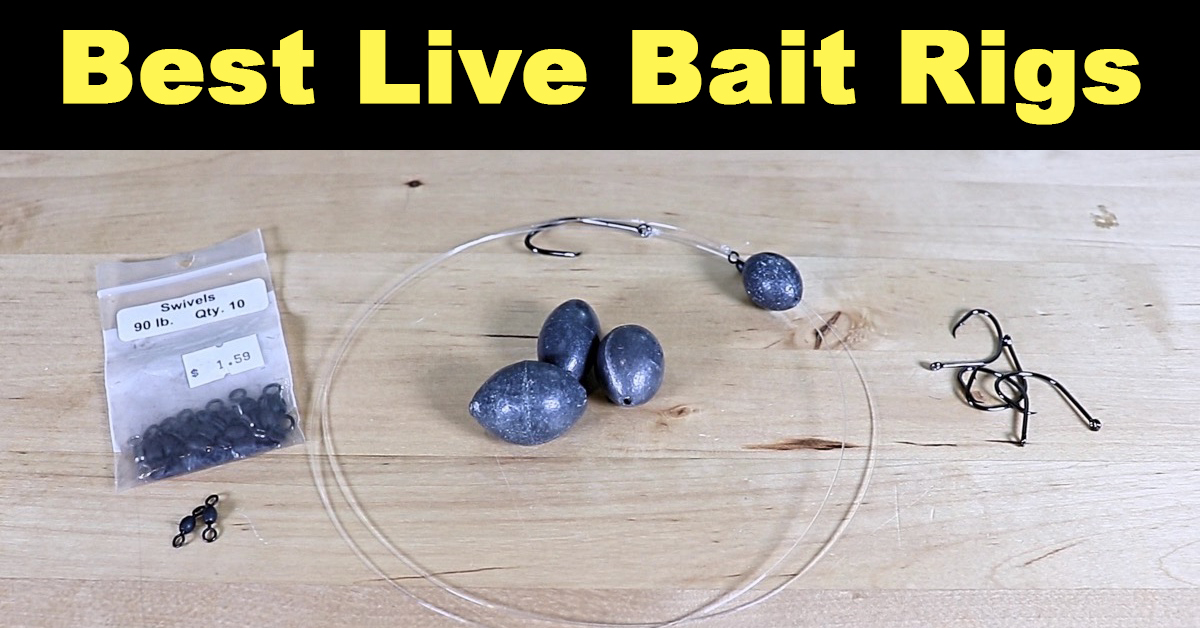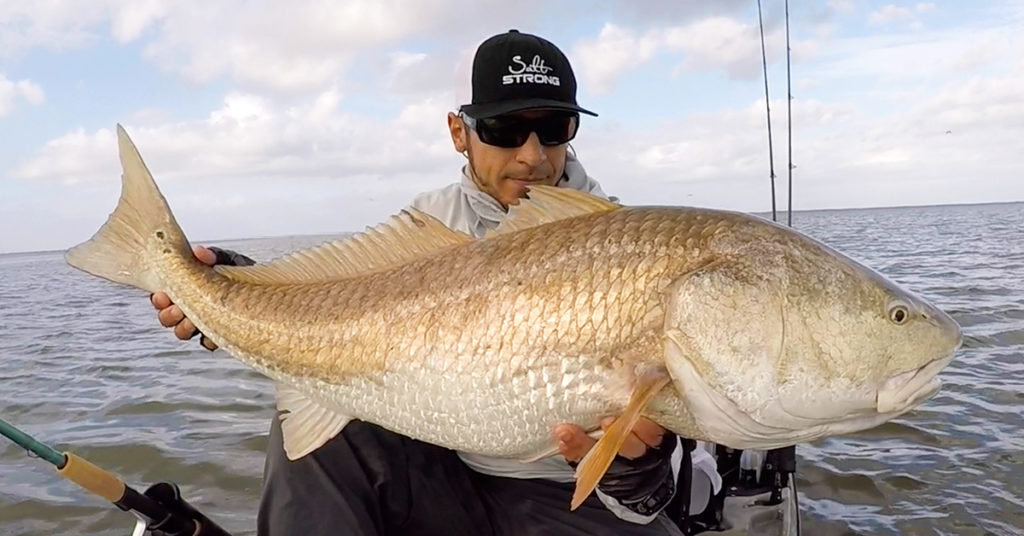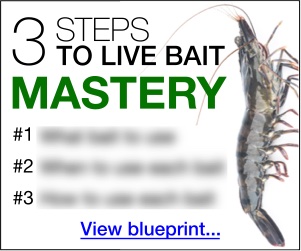Best Live Bait Rigs For Inshore Fishing (To Rig Shrimp, Pinfish, Mullet)
- By: Tony Acevedo
- on

One of the biggest mistakes people make when fishing with live bait is not rigging them correctly.
Live bait fishing is all about presentation.
You want your bait to look natural.
But if you rig it incorrectly, the fish are going to know something is off.
So in this video, you’ll learn what my top three favorite inshore live bait fishing rigs are, how to tie them, and why you NEVER want to buy pre-tied rigs from the store.
Check it out below!
Top 3 Live Bait Rigs [VIDEO]
Why You Never Want To Buy Pre-Tied Rigs From The Store
Store-bought rigs are a waste of money!
And even worse, they’re probably costing you fish.
Most rigs from the store have extra flashy stuff on them to get anglers to buy them.
But the truth is, some of that flash will scare off fish and cause your bait to look unnatural.
And another reason why you don’t want to buy pre-tied rigs is because you don’t always know what the conditions you’re fishing in will be.
Depending on the depth, current, or bait size, you may need different weights or hook sizes.
What Materials You Need To Tie Your Own Rigs
Effective live bait rigs are simple.
Here’s all you need:
- Leader material. Monofilament or fluorocarbon can work, but unless you’re fishing gin clear water, go with the cheaper mono.
- Hooks. I usually use circle hooks if I’m using live or cut bait, but if I’m using big live bait like mullet or pigfish, and I’m actively fishing, I’ll use a j hook. And remember, the size of the hook depends on the size of the bait, NOT the size of the fish you’re targeting.
- Swivel. I like these SPRO ball bearing swivels.
- Sinker. I prefer egg sinkers and the weight of the sinker will depend on depth and current.
Top 3 Inshore Live Bait Rigs
Here are my three favorite inshore live bait rigs:
Free Line Rig
This simple rig requires just a hook and leader.
If you’re trying to keep your bait on the surface or high in the water column, or you’re fishing in shallow water, this rig is perfect.
All you need to do is tie the hook to about two feet of leader, tie your leader to your main line with an FG knot or double uni knot and you’re good to go!
Fish Finder Rig
If you’re fishing in deeper water and/or in heavy current, but you want to give your bait some freedom to swim on the bottom, this rig is for you.
First, thread the sinker onto the main line.
Then, tie your main line to the swivel.
Finish it up by tying your leader to the swivel and hook to your leader.
The swivel helps keep your line from getting twisted and it keeps the sinker from sliding down to the bait.
The only con with this rig is that if you try to cast far you’re likely going to get tangled up because of the distance between the hook and the sinker.
So if you’re dropping your bait straight down onto a reef or next to a bridge piling, this is a great rig.
Knocker/Fish Finder Rig Combo
This rig is similar to the fish finder rig, but casts much better.
First, tie your main line to the swivel.
Next, tie your leader to the swivel.
Finally, thread your sinker onto the leader before you tie on your hook.
The difference between this and the fish finder rig above is that the sinker is between the hook and the swivel.
This lets it cast farther and keeps your bait close to the structure because the sinker is blocked by the swivel so the fish can’t free swim.
Conclusion

Knowing how to tie these rigs can save you money and help you catch more fish by presenting your bait naturally.
You can get the materials for these rigs here:
Have any questions about these rigs?
What’s your favorite live bait rig?
Let me know down in the comments.
And now that you know how to rig live bait, you need to find where the fish are!
If you need help doing that, join us in the Insider Club where we’ll show what and where the fish are biting right now.
Click here to join us in the Insider Club!
Related articles:
Related categories:
STOP WASTING TIME ON THE WATER!
Do what the “SMART ANGLERS” are doing and join the Insider Club.
Here’s what you’ll receive today when you join:
- Weekly fishing reports and TRENDS revealing exactly where you should fish ever trip
- Weekly “spot dissection” videos that walk you through all the best spots in your area
- Exclusive fishing tips from the PROS you can’t find anywhere else
- Everything you need to start catching fish more consistently (regardless if you fish out of a boat, kayak, or land).
STOP WASTING TIME ON THE WATER!
Do what the “SMART ANGLERS” are doing and join the Insider Club.
Here’s what you’ll receive today when you join:
- Weekly fishing reports and TRENDS revealing exactly where you should fish every trip
- Weekly “spot dissection” videos that walk you through all the best spots in your area
- Exclusive fishing tips from the PROS you can’t find anywhere else
- Everything you need to start catching fish more consistently (regardless if you fish out of a boat, kayak, or land).











Rather than putting the egg sinker below the swivel, could you instead use a split shot to keep the line from tangling while casting?
Hey Jay!
I’m not sure that would help. The bait itself is pretty heavy and that doesn’t keep it from spinning and tangling. It’s more due to the weight being above the swivel and then having a loose line underneath it.
I ordered a bait from you and you got the address wrong account number 940011110840090101 or shipping # it’s was 2222 Se 1 st Ave it was right on my end but you forget ave on your shipping end
wish we had a club like this in southern California
Great discussion. Being from SC we also call The fishfinder rig a Carolina rig. When I’m fishing and the currents are not as strong like in the creeksI like to switch to a bullet weight. I find it does not get hung up as easily and I don’t need as much weight when this current isn’t real strong. I also like to put a SMALL split shot just above the swivel to keep the weight from slamming down on my knot where the braid line attaches to the swivel.
Thank you for the great feedback Craig!
When did they start calling a Carolina rig a fish finder rig ?
They are pretty much the same as far as swivel placement and weight placement. I believe how it is used really determines the proper “name”. The Carolina Rig name seem to be used when fishing artificial lures, and the fish finder rig tends to lean towards using live/dead bait. The fish finder rig also uses a sliding snap above the swivel that you can snap a pyramid sinker onto to help keep the weight in place on the bottom. Either way, they are both the same as far as hook, swivel, and weight placement.
Hey guys, just want to thank yall for all the info yall been putting out I went out fishing yesterday and was killing it from the bank, I went to several spots and from what I was hearing was that people were not having any luck so I did the following, started casting to structure and over hangs from trees I was putting on a show for a lot of anglers on ultra light gear thank you for all yalls tips on the YouTube videos 👍👍
Thats awesome Jose!
Thank you so much for the kind words and support!
Tony,
Do you have a rule of thumb for sinker weight vs current speed?
Hey Colin!
Not necessarily. It usually turns into trial and error because many factors come into play. Such as current speed, depth, line thickness (thicker lines have more resistance and will catch the current more), wind speed (wind will catch and drag your line as well), and positioning (cross current vs. staying in line with the current.
I have a small box of egg sinkers ranging from 1/2oz to 4oz
So what are the beads for, Tony? I see those all the time on the hated store-bought rigs.
The main purpose that I know of for the beads is that they are usually used to keep an egg sinker from banging against knots. But I just make sure to check my egg sinkers and make sure the ends are smooth. they can be easily cleaned with a file. Other than that I don’t see much of a use or purpose for beads unless they are on a popping cork or other type of rig to create noise for attraction,
Question two: Sorry! You did a video on big chunks of mullet looking for bigger redfish. What size hooks would you use for that type of fishing? Thank you again.
Hey Jeff!
I use a 6/o circle hook for large reds using chunks of mullet.
Thank you Tony. Great instruction as always. I have one question about the knot you use to attach the hook to the leader. what type of knot do you like to use to tie on hooks for these rigs? I like to use a snell knot because it is easy for me. I’m unsure if this is the correct knot to use on these rigs. Does a snell knot hurt the performance of a circle hook doing it’s job? Thank you!
My pleasure Jeff!
I use a trilene knot for most applications. I don’t think a snell knot would affect anything.
Thank you Tony! I’m going out on the boat today.